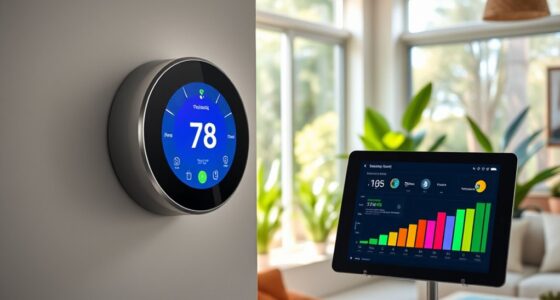By leveraging AI predictions, you can optimize grid operations, reducing waste and increasing renewable energy use. AI analyzes weather, social patterns, and historical data to forecast peak demand accurately. This helps you avoid overproduction and better manage fluctuating renewable sources. As a result, you’re likely to see lower energy costs and a more stable, sustainable power supply. To discover how AI continues to enhance energy efficiency, keep exploring these innovative strategies.
Key Takeaways
- AI predicts peak energy demand using weather, social data, and historical trends to optimize energy production timing.
- Real-time AI models adjust energy output dynamically, reducing waste during low-demand periods.
- Forecasting renewable energy availability enables strategic integration, decreasing reliance on costly fossil fuels.
- Accurate demand predictions lower operational costs and energy prices for consumers.
- Continuous AI advancements enhance grid stability, efficiency, and the ability to maximize green energy use.

Have you ever wondered how artificial intelligence can help reduce your energy bills? One of the key ways AI makes a difference is through renewable integration and demand forecasting. These technologies enable power grids to operate more efficiently, which means lower costs for you and a more sustainable energy system overall. When renewable sources like solar and wind are integrated seamlessly into the grid, power companies can better balance supply and demand, reducing reliance on costly fossil fuels. AI algorithms analyze vast amounts of data to predict when renewable energy will be available, smoothing out fluctuations and ensuring a steady flow of clean energy. This not only helps reduce emissions but also stabilizes energy prices, saving you money.
Demand forecasting is another vital element. By leveraging AI, utility providers can accurately predict peak usage periods and adjust their energy distribution accordingly. This means avoiding unnecessary energy production during low-demand times and preparing for high-demand periods efficiently. When predictions are precise, power plants aren’t overproducing or underproducing, which cuts down on waste and operational costs. These savings are often passed down to consumers in the form of lower bills. Plus, demand forecasting helps prevent blackouts and brownouts by ensuring the grid is prepared for sudden surges in consumption, keeping your lights on and appliances running smoothly.
AI-driven models take into account various factors, including weather patterns, historical usage data, and even social behaviors, to make real-time predictions. As a result, energy providers can optimize their operations, making smarter decisions about when to ramp up or scale back generation. This level of precision is especially important when working with renewable energy, which can be unpredictable. By accurately forecasting demand and renewable supply, AI helps maximize the use of green energy while minimizing the need for backup fossil fuel sources. This creates a more resilient, cost-effective grid that benefits everyone.
In essence, AI’s ability to improve renewable integration and demand forecasting means your energy system becomes more intelligent and adaptable. It reduces waste, lowers costs, and supports a greener future, all while helping you save money. As these technologies continue to evolve, expect even more precise predictions and smarter energy management—making it easier for you to enjoy reliable, affordable, and sustainable power. So, the next time you see a smart energy app or notice your utility company deploying new tech, you’ll know it’s all about leveraging AI predictions to deliver peak energy savings directly to your home. Advancements in AI technology continue to drive these improvements, promising a more efficient energy future for everyone.
Frequently Asked Questions
How Does AI Predict Energy Consumption Patterns Accurately?
You can see how AI predicts energy consumption patterns accurately by analyzing vast amounts of data, allowing the AI model accuracy to improve over time. It identifies energy consumption trends by examining factors like weather, time of day, and user behavior. This helps you anticipate peak usage periods, optimize energy use, and reduce costs. Continuous learning from new data guarantees predictions stay reliable and precise, making your energy management smarter and more efficient.
What Data Sources Are Used for AI Energy Predictions?
You use data sources like smart meters, weather forecasts, and grid information to predict energy consumption. Consumer behavior data helps refine these predictions, showing how habits impact usage. Renewable integration data tracks how solar and wind generation affect supply. Combining these sources, AI models analyze patterns to forecast demand accurately, enabling optimized energy management. This approach guarantees efficient energy use while accommodating renewable sources and understanding consumer habits.
Can AI Predictions Adapt to Sudden Weather Changes?
AI predictions can adapt to sudden weather changes, but their accuracy depends on prediction robustness. Weather variability poses challenges, yet advanced AI models incorporate real-time data, enabling quick adjustments. These models analyze recent weather trends to refine forecasts, improving reliability during unexpected shifts. While not perfect, this adaptability helps optimize energy use, ensuring more efficient peak savings even when weather conditions change abruptly.
How Secure Is the Data Used in AI Energy Models?
You can trust that the data used in AI energy models is protected through strict security protocols and data privacy measures. Companies implement encryption, access controls, and regular audits to safeguard your information. While no system is completely invulnerable, these protocols markedly reduce risks, ensuring your data remains confidential and secure. Rest assured, safeguarding your data privacy is a top priority in AI energy management systems.
What Are the Limitations of AI in Energy Forecasting?
You should know that AI in energy forecasting faces limitations like algorithm bias, which can skew predictions if the training data isn’t diverse enough. Data privacy concerns also restrict access to extensive datasets, reducing model accuracy. Additionally, AI models often struggle with unpredictable factors like sudden weather changes or policy shifts, which can lead to less reliable forecasts. These issues highlight the importance of improving data quality and addressing bias.
Conclusion
By harnessing AI predictions, you can open significant energy savings. Imagine a commercial building that uses AI to optimize HVAC schedules, reducing energy use by 20% during off-peak hours. This proactive approach not only cuts costs but also benefits the environment. As technology advances, your ability to make data-driven decisions will become even more precise, helping you achieve sustainable energy efficiency effortlessly. Embrace AI and watch your energy management transform.









